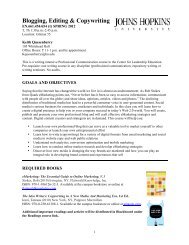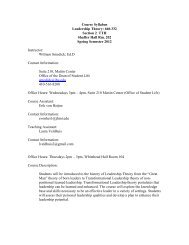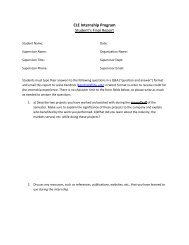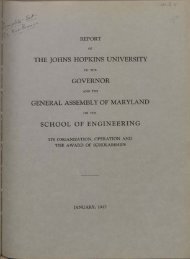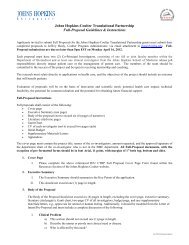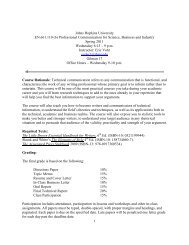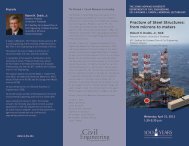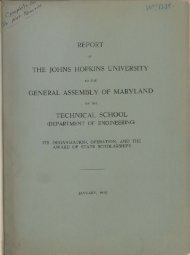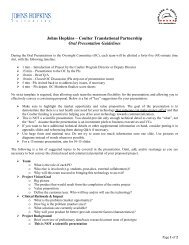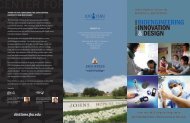Read More - Johns Hopkins University
Read More - Johns Hopkins University
Read More - Johns Hopkins University
Create successful ePaper yourself
Turn your PDF publications into a flip-book with our unique Google optimized e-Paper software.
A Time of Change<br />
The Department continued to take pride in the well-rounded education<br />
it offered. Its course requirements allowed students a good number<br />
of electives, both within the Department and in other departments,<br />
particularly the humanities and social sciences. The proportion of nonengineering<br />
classes gradually declined, but the emphasis on a liberal education<br />
was renewed after World War II; in the decades of the 1950s and 1960s other<br />
universities followed <strong>Hopkins</strong>’ example in this regard.<br />
In the 1950s, a number of significant<br />
changes across the engineering school<br />
signaled a shift from “practical”<br />
engineering instruction to one<br />
focused on fundamentals of the<br />
discipline. In 1960, a proposal was<br />
approved to merge the Departments<br />
of Civil Engineering, Mechanics, and<br />
Aeronautics into a single Department<br />
of Mechanics with George S. Benton<br />
as chair. The faculty of the three<br />
departments recognized that aspects<br />
of their disciplines had become<br />
obsolete, and that their common interests in the broad field of mechanics –<br />
fluid mechanics, solid mechanics, and several areas of classical physics – might<br />
flourish in an integrated environment.<br />
In 1966, the School of Engineering merged with the Faculty of Philosophy<br />
to form the School of Arts and Sciences, diminishing the presence of civil<br />
engineering even further. Engineering alumni were understandably upset, and<br />
within a decade, it became clear to all that the merger had been a mistake.<br />
Through the efforts of many, including civil engineers and university trustees<br />
Willard Hackerman ’38 and F. Pierce Linaweaver ’55’65, the university made the<br />
commitment to create an academic center of excellence in the new engineering<br />
school. Mr. Hackerman was instrumental in securing a gift from the estate of<br />
G.W.C. Whiting, co-founder of the Whiting-Turner Contracting Company, to<br />
fund (and name) the new school.<br />
Even though the engineering school was re-established in 1979, the civil<br />
engineering department was not yet back to full strength. Rather, it combined<br />
with materials science to form the Department of Materials Science and<br />
Engineering/Civil Engineering. This made sense, according to the late Robert B.<br />
Pond, Sr., materials science and engineering professor, because “so much of civil<br />
engineering is materials.”



